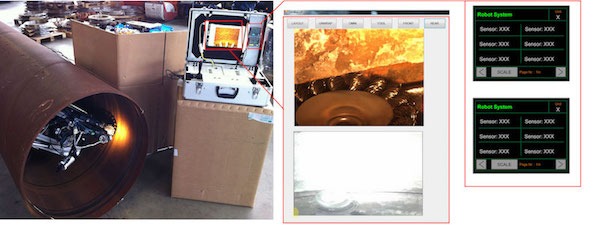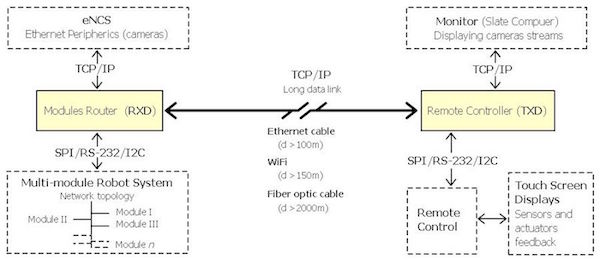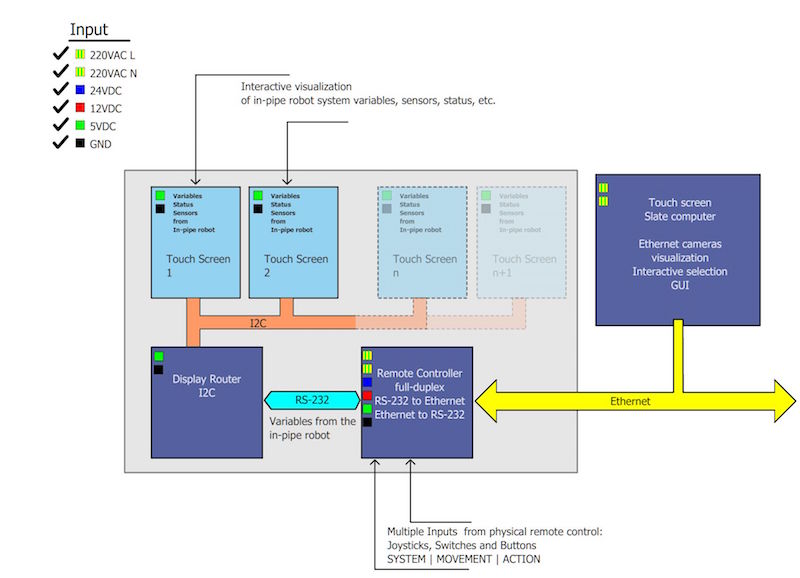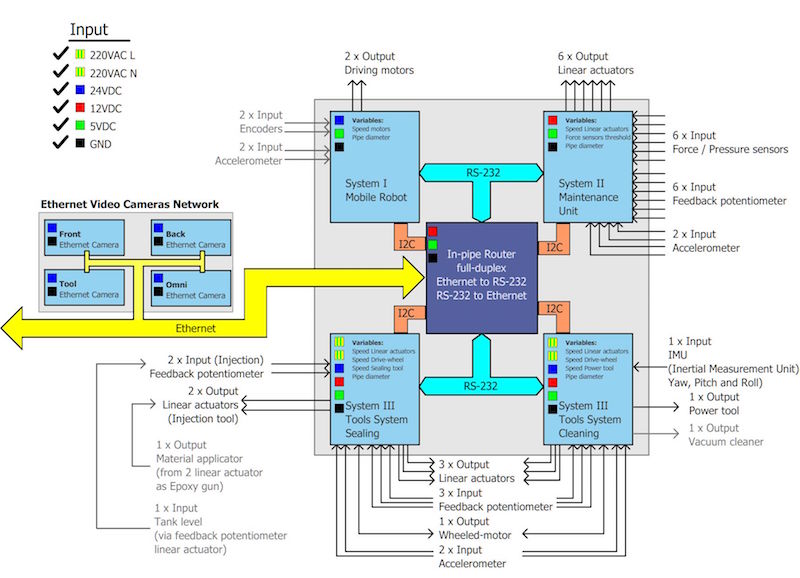The control station is located outside the pipe monitoring and controlling the in-pipe robot. It consists of a remote control with integrated slate computer for visualizing the cameras images and four 2.8” TFT touch-screens for visualizing sensors values and in-pipe robot status.

DeWaLoP remote control with LCD screens for display the cameras and sensors data.
DeWaLoP remote control.
The physical remote control can be multiplexed in order to select, operate and upgrade the different robot modules, while reusing the hardware configuration. In the same way, new functional modules can be added to the robot with minimum effort. Furthermore, the physical communication medium can be modified without affecting the system functionality.
The DeWaLoP communication protocol involves TCP/IP, RS-232 and I2C over ethernet. In this configuration, peripherals with different communication protocols are unified to a single channel. TCP/IP over ethernet is used for the long distance data link, transmitting remote control commands, sensors values, video streams and actuators status between the in-pipe robot and the remote controller. While the communication between the robot systems, as well as inside the remote controller is made with micro-controllers serial interfaces such as SPI / RS-232 / I2C. In this way, the cores communicate efficiently in their native protocols, enabling the use of simultaneous parallel lines for data processing, [Mateos et al., 2011].
TCP/IP over ethernet is commonly used for long distance data link. It is reliable, specifying how data should be formatted, addressed, transmitted, routed and received at the destination. Moreover, due to its connectivity the protocol can be carried in twisted pair cable, coaxial cable, fiber optic or wireless (WiFi). However, if the communication does not require to transfer data over long distances, neither with high communication speeds, simpler protocols should be used to reduce complexity and computational power. For example, motor drivers and sensors, such as accelerometers require low speed communication protocols (SPI, RS-232 or I2C).

Combining protocols in DeWaLoP.
The remote controller TXD includes five subnetworks, an initial ethernet network for transmitting tasks and receive data from the robot RXD. Two independent but parallel subnetworks TXD1a for controlling the robot and TXD1b for visualizing the robot cameras. In the remote controller network TXD1a includes two more subnetworks in line network topology TXD2a and TXD3a that are required for processing and displaying the robot status and sensors data.

On the robot RXD, ethernet cameras and a micro-controller, referred as robot router are connected to the robot ethernet hub as initial network. From the robot router, each robot module creates its own network RXD2an and communicates to the robot router in RS-232. Additionally, each robot module connects to the robot router via I2C sending its sensors values, module status and actuators feedback data, creating in the same network two different communication lines

The DeWaLoP communication protocol for the long data link, between the remote control TXD and the robot RXD consists of 3 parameters. Each parameter is represented as a byte and therefore the system uses 3 bytes word, where the first byte encodes the robot module to work with, the second byte encodes the movements (joysticks data) and the third byte encodes the task to be performed by the robot module.
The DeWaLoP remote control is located outside the pipe monitoring and controlling the in-pipe robot. It consists of a remote control with multiple touch-screens displays to visualize the camera images and sensors values from the in-pipe robot.
The physical remote control can be multiplexed in order to select, operate and up grade the different robot modules, while reusing the hardware configuration. In the same way, new functional modules can be added to the robot with minimal effort. Furthermore, the physical communication medium can be modified without affecting the system functionality.
The DeWaLoP communication protocol integrates TCP/IP, RS-232 and I2C over ethernet. In this configuration, peripherals with different communication protocols are unified to a single channel. TCP/IP over ethernet is used for the long distance data link, transmitting remote control commands, sensors values, video streams and actuators status between the in-pipe robot and the remote controller. While the communication between the robot systems, as well as inside the remote controller is made with micro-controllers serial interfaces such as SPI / RS-232 / I2C. In this way, the cores communicate efficiently in their native protocols, enabling the use of simultaneous parallel lines for data processing, [Mateos et al., 2011].
